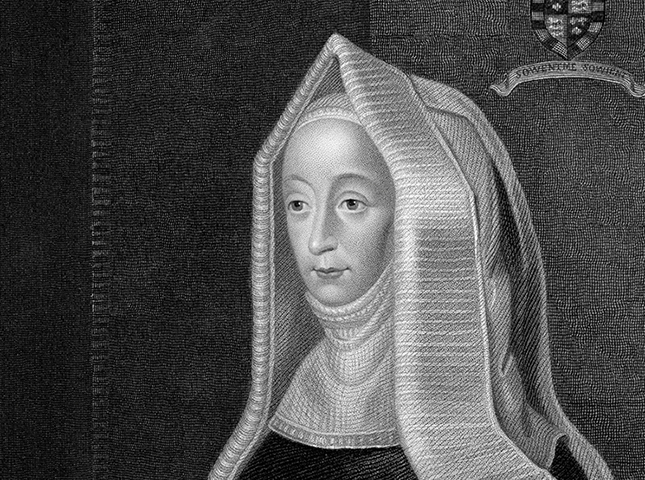Together with Tudor Times we profile a different figure every month. Here, Melita Thomas tackles the mother of the Tudor dynasty.

Popular fiction, re-imagining the Wars of the Roses, has brought Lady Margaret Beaufort from relative obscurity to the fore as a key protagonist. Fiction needs a villain, so she is often portrayed as a scheming ‘tiger mother’ prepared to do anything, even murder, to promote her son. But what was the reality of Margaret’s life?
Many of Margaret’s experiences were typical of the life of a late mediaeval noble-woman – royal blood, arranged marriages, loss of two husbands in battle, and, finally, the triumph of her house.
Like other participants in the Wars of the Roses, Margaret was a descendant of Edward III, through his son, John of Gaunt, Duke of Lancaster. Following the shocking death of her father, John, Duke of Somerset, probably by suicide, when she was only a year old, Margaret became a great heiress. This made her a valuable commodity on the aristocratic marriage market and her wardship was granted to the King’s chief minister, the Earl of Suffolk.
Suffolk swiftly arranged a marriage to his son, John de la Pole, but the match was annulled when the earl was disgraced. Margaret’s wardship and marriage were then granted by her cousin, Henry VI, to his Tudor half-brothers, Edmund and Jasper, Earls of Richmond and Pembroke respectively.
In order to keep her fortune close, Margaret was married to Edmund not long after reaching the legal age of 12, and, despite her youth, soon became pregnant. Such early consummation of a marriage was unusual, but certainly not unknown. Then tension between the Duke of York and the Lancastrian government boiled over into the Wars of the Roses, and after a year of matrimony, Margaret was widowed, when the opening hostilities led to the death of her Lancastrian husband.
Margaret took refuge with her brother-in-law, Jasper, giving birth to a son, Henry Tudor, in January 1457. But a young widow needed protection and she was quickly married to Lancastrian Sir Henry Stafford. Following the annihilation of the Lancastrian army at the battle of Towton in 1461, Stafford and Margaret were reconciled with the Yorkist regime and lived an apparently harmonious life.
In 1470, the Lancastrians made a brief resurgence and Henry VI regained his throne. Stafford was in a quandary – should he re-join the Lancastrians, led by Margaret’s cousin, the Duke of Somerset, or should he adhere to Edward of York? In the event, Stafford chose the winning side, supporting Edward at the Battle of Barnet. Badly injured, he died within six months. Margaret had now lost a husband to each side. Meanwhile, Lancastrian Jasper escaped to Brittany with her son Henry.
After her year of mourning, Margaret chose a new husband, Lord Thomas Stanley. Stanley, although reticent about supporting either Lancaster or York, was a good servant to Edward IV and he and Margaret became part of the court circle. Margaret maintained a good relationship with Edward IV’s Queen, Elizabeth Woodville, even carrying one of her children, Bridget, to her baptism.
With the Yorkist kings firmly established, Margaret tried to negotiate her son’s return from Brittany. She hoped that Edward IV would recognise him as Earl of Richmond and restore his patrimony but, while negotiations were underway, Edward died.
A swift coup by Richard, Duke of Gloucester, deposed Edward’s son, Edward V. Initially Stanley and Margaret supported Richard, Margaret even carrying the train of Queen Anne Neville at the coronation. However, the usurpation attracted murmurings of discontent from previously loyal Yorkists and Margaret was soon communicating secretly with her nephew-by-marriage, Henry Stafford, Duke of Buckingham, who staged a rebellion in summer 1483. Following Buckingham’s defeat, Margaret’s part in the rebellion was punished by confiscation of her lands and their re-grant to her husband. Margaret herself was to remain under house arrest.
Eighteen months later, supplied by Margaret with large sums of money, Henry Tudor landed in Wales with a small invasion fleet, winning the crown at Bosworth on 22 August 1485. He was now Henry VII – such legal claim as he had being entirely based on his descent, via Margaret, from Edward III.
Margaret, called “My Lady, the King’s Mother”, was given the legal position of a ‘femme sole’, meaning she was no longer subject to her husband’s authority in the management of her restored and augmented lands – a freedom normally reserved for widows or Queens. Frequently at court, Margaret’s status was almost equal to that of her daughter-in-law, Queen Elizabeth of York. Amid evidence of a generally warm relationship, there is the odd hint that Elizabeth occasionally felt a little restive under her mother-in-law’s pervasive influence.
Educational schemes became Margaret’s focus. She founded the Lady Margaret professorships in divinity at Oxford and Cambridge universities and two Cambridge colleges: Christ’s and St John’s.
When her beloved son’s death in April 1509, Margaret organised the funeral obsequies and participated in the establishment of the new King’s council. She died a couple of days after the coronation of her grandson, Henry VIII – following over-indulgence on a feast of cygnet.
Margaret was buried in Henry VII’s chapel Westminster Abbey where her sumptuous bronze tomb effigy, carved by the Italian sculptor, Pietro Torregiano, may still be seen.
Related articles
|
Click here to subscribe! |
Download BRITAIN Magazine to your mobile today






 © 2024
© 2024